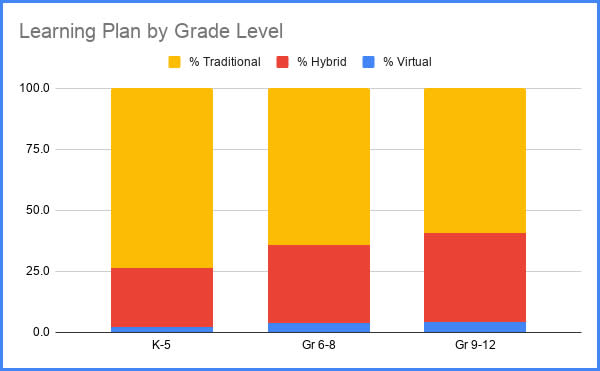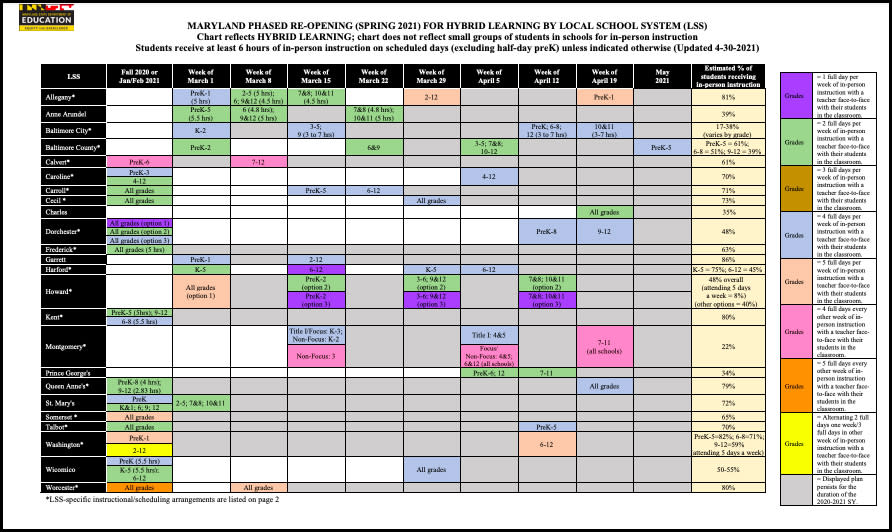Reopening Roadblocks & 7 Other Key Updates

Biden’s 100-day mark in the White House came and went last week, and most experts agree that the president has made good on his promise to reopen classrooms. Weeks before his January inauguration, which coincided with the mid-winter peak in coronavirus cases, more than half of American students were attending remote-only schools. Now, the share stands at just 3 percent.
But opening classrooms does not guarantee that students actually select in-person learning. In many population-dense urban school districts, a troubling trend has begun to emerge: Even after schools open their doors, a majority of students are turning down the chance to return.
That raises questions about what it will take to bring students back to classrooms not just this spring, but into next fall. How will schools manage distancing protocols if they are met with an influx of students in September? Or if families opt to keep students remote into next school year, how will districts allocate resources to beef up online learning options?
From state mandates against “hybrid” learning next year — stipulating that schools must be either fully remote or fully in person — to freshly minted virtual learning academies, schools and districts are prepping for what is shaping up to be another challenging fall.
Here’s what you need to know about the state of play on school reopenings across the nation, powered by data and insights from the school calendar tracking website Burbio.
1 Share of remote middle and high schools shrinking
Across the country, younger students have been the first to return to classrooms once districts open their doors. As a result, the share of middle and high school students attending remote-only schools has remained a notch above that of elementary schoolers for months.
This week, however, the share of older students in online-only schools nearly caught up to youngsters — each edging toward zero.
Just 4 percent of middle and high school students still lack access to in-person learning, both down from 8 percent last week. Remote-only rates for elementary students fell from 3 percent to 2 percent.
Fifty-nine percent of high schoolers and 64 percent of middle schoolers go to schools with daily in-person instruction, compared to nearly three-quarters of younger students.

2 Opt-out rates remain high in many cities
Even as schools increasingly open their doors, many classrooms remain at only a fraction of capacity.
Between 10 and 30 percent of students continue to opt out of in-person learning outside of urban areas. And in most cities, according to the Burbio data team, rates of virtual learning remain well over 50 percent.
Nearly 60 percent of Atlanta students have turned down the chance to return to classrooms, and in Chicago, which underwent a drawn-out battle between its teachers union and district officials over reopening, under 24 percent of students eligible for in-person learning have opted in. In New York City, the nation’s largest district, 61 percent of students are choosing to continue with remote learning.
3 Roadblocks to reopening in the fall
Thanks to high rates of opt-outs from in-person learning in most cities, many of the nation’s largest districts have not yet had to contend with how to manage full-capacity schools during a pandemic.
That could pose a challenge to schools in the fall. Though the CDC reduced its classroom distancing guidance from 6 to 3 feet, 6-foot recommendations remain in place while students eat, and busing also presents a logistical challenge for many districts. If families choose to return their kids to schools at high rates next fall, managing these protocols could be a tight squeeze, Burbio co-founder Dennis Roche predicts.
“[Many urban districts] haven’t had to manage space as efficiently as they will need to if 90%+ of their student bodies return. It would seem that the current guidance may become an issue in some of these areas at that time,” Roche wrote in his most recent update.
Additionally, districts that have juggled irregular schedules — including shortened weeks, reduced hours, and alternating schedules — will still need to expand instructional time next fall in order to return to the typical school day.

4 States require full-time in-person learning
Amid uncertainty about the return to classrooms next year, some states have taken matters into their own hands.
In Massachusetts, the education commissioner ordered high schools to offer daily in-person learning by May 17, supplementing similar rules already in place for the elementary and middle school levels. The Virginia legislature passed a bill requiring districts to offer full-time in-person learning in the fall. And the state Board of Education in Maryland passed a similar resolution, though with softer, non-binding language.
5 Districts plan virtual offerings for 2021-22
As school systems brace for an influx of in-person students next fall, there’s also a chance many parents will continue to choose virtual school. Districts are readying themselves for both possibilities.
In Tennessee, the state Board of Education ruled that school systems cannot offer remote and in-person instruction simultaneously next year, meaning that families selecting virtual learning will have to do so in dedicated online academies. That has pushed Nashville to plan remote school options for grades 4-12, enrolling now for next school year.
Related: Teaching the ‘Roomers’ and the ‘Zoomers:’ No Small Task for Elementary School Teachers
Tuscaloosa, Alabama; Hillsboro, Washington and North Kansas City, Missouri — among others — are all planning similar virtual academies for next year.
6 Over 10 million students still lack option for traditional in-person learning
Despite widespread progress toward fully reopened classrooms, many districts have not yet made the leap to daily, in-person learning and remain in either virtual or hybrid models. Together representing well over 10 million students, these youth have not had access to traditional school in over a year.
These districts will face the largest transitions if they seek to return to full-time in-person learning in the fall.

7 School vaccine mandates unlikely this fall
Youth 12 and up appear poised to become eligible for COVID-19 vaccines this summer. But even if many middle and high schoolers are approved for shots, schools are unlikely to mandate inoculation.
That’s because school vaccination requirements are dictated by state laws, and adding to that list involves an intricate — and often lengthy — policy dance between the federal and state government.
Coronavirus vaccines have been given the green light for emergency use by the federal government, but still lack full FDA approval.
“I think a lot of states will wait on full FDA approval to move on this,” Dorit Reiss, professor of law at UC Hastings College of the Law and a specialist in vaccine policy, told The 74 in April. “No state has ever added a vaccine that wasn’t recommended and I don’t think they will.”
In the meantime, schools will have to figure out how to safely serve a mixture of vaccinated and unvaccinated students this fall.
Related: FDA Authorizes Vaccines For Youth 12 & Up, But Schools Unlikely To Require Shots
8 Relief funds to find homeless students lost during virtual learning
About 1.5 million school-age children in the United States are homeless, according to federal data. Last fall, researchers estimated that many of those youth were among the 1 to 3 million students potentially missing from classrooms during remote learning.
“No one at the school knew we were homeless,” Portia, a Massachusetts mother of two told The 74 in April.
Now, funds are going to support families like Portia’s. Under the $1.9 trillion economic stimulus bill passed in March, the federal government has dedicated $800 million to support homeless students, a commitment that advocates say will go a long way to finding those students and addressing their needs.

